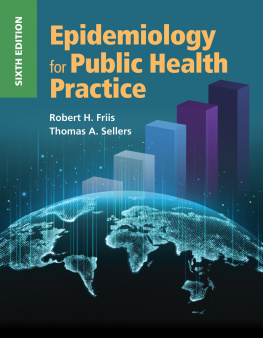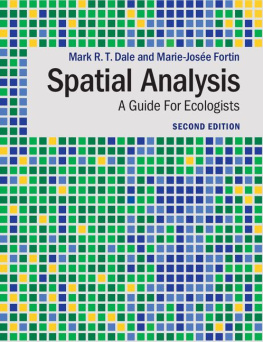
Epidemiology and Geography
Principles, Methods and Tools of Spatial Analysis
Marc Souris

First published 2019 in Great Britain and the United States by ISTE Ltd and John Wiley & Sons, Inc.
Apart from any fair dealing for the purposes of research or private study, or criticism or review, as permitted under the Copyright, Designs and Patents Act 1988, this publication may only be reproduced, stored or transmitted, in any form or by any means, with the prior permission in writing of the publishers, or in the case of reprographic reproduction in accordance with the terms and licenses issued by the CLA. Enquiries concerning reproduction outside these terms should be sent to the publishers at the undermentioned address:
ISTE Ltd
27-37 St Georges Road
London SW19 4EU
UK
www.iste.co.uk
John Wiley & Sons, Inc.
111 River Street
Hoboken, NJ 07030
USA
www.wiley.com
ISTE Ltd 2019
The rights of Marc Souris to be identified as the author of this work have been asserted by him in accordance with the Copyright, Designs and Patents Act 1988.
Library of Congress Control Number: 2018965282
British Library Cataloguing-in-Publication Data
A CIP record for this book is available from the British Library
ISBN 978-1-78630-360-8
Foreword
This book is the result of a long series of scientific works that the author has conducted for over 30 years. With an initial background in mathematics and computer science, Marc Souris is one of the few researchers who have focused their research efforts on the methodological development applied to spatial data, which he realized through many research programs involving various disciplines (geology, geography, epidemiology, etc.). Due to his quite unique positioning, his capacity to go beyond the frontiers of his initial academic training and his ability to clearly and objectively present principles that may seem complicated at first glance, this work has a particularly remarkable and unique character.
This book offers a very rich state of the art of the concepts, methods and tools of spatial analysis currently used in epidemiology and in certain works related to health geography, and that the author has intelligently organized in coherent chapters. This type of book is all the more valuable as overviews covering such a wide range of methods are rare. The author devotes particular attention to describing the formalism, the terminology and the scientific approach to be adopted by anyone willing to apply spatial analysis in the health field. The author warns, and with good reason, on the numerous pitfalls (confusion factors, ecological error, layout of spatial substratum, edge effect, etc.) and limits (oversimplification of reality, inadequacy between the level of analysis and the spatial scale of the processes, data reliability, uncertainty in localization, etc.) that have to be dealt with and for which solutions are proposed. The author uses compelling examples, particularly in relation to vector-borne infectious diseases, without, however, omitting other categories of diseases (notably chronic or degenerative diseases, such as long-term disorders or diabetes), although the latter are less often mentioned in this book. The examples refer to study sites predominantly located in southern countries (Latin America, Southeast Asia and Africa).
A further very significant aspect is that the methods are presented in a highly didactic manner, by means of simply formulated questions to which they allow an answer. Whenever possible, several software solutions are suggested in order to implement the advocated methods. Furthermore, it is worth noting that Marc Souris has himself optimized a number of methods presented in this book and has also developed new ones, among which is an operational implementation using the SavGIS free software.
Finally, this book features a balanced integration of theoretical and methodological issues, practical examples and elements related to the software to be used. There are summaries at the end of each chapter, numerous illustrations (maps and graphic representations), many boxed texts, a glossary, a rich bibliography and two detailed practical cases, all of these presented in a very accessible style, which facilitates the reading experience. Although it primarily addresses students enrolled in Master and PhD programs, researchers, research analysts or managers working in the healthcare sector, it is also a further reaching resource that can prove valuable for anyone willing to acquire knowledge on spatial analysis methods, regardless of the field of application.
Florent DEMORAES
Lecturer and Researcher University of Rennes 2,
Deputy Director of UMR 6590 ESO
(Spaces and Societies CNRS)
Preface
I lie only to tell the truth
Chinese proverb
This book gives an overview of the objectives, principles and methods of spatial analysis and of geographic information systems used in the healthcare sector, and particularly in the study of infectious diseases and of healthenvironment relations. It is designed as a practical introduction to spatial and space-time analysis for epidemiology and health geography. Its objective is to offer a detailed description of the objectives, concepts, and most of the methods and techniques available in this field, with a didactic approach illustrated by concrete examples. It is aimed at students and public health professionals, epidemiologists, public health inspectors, health geographers and experts in (human or animal) healthenvironment relations, who are interested in a comprehensive overview of the subject that does not require in-depth mathematics or statistics knowledge. Finally, the book also aims to be a tool that can be used by all of those interested in an introduction to the general methods of spatial analysis.
Spatial analysis includes any technique that studies objects and their attributes using topological or geometric properties, generally in a two- or three-dimensional metric space. This is a very general definition that applies to many domains. Spatial analysis is not a recent discipline; it has been used for many years in biology, botany, epidemiology, image processing, network analysis, electronic design, chemistry, cosmology, climatology, hydrology, economics, etc. Obviously, it has been used in geography, where spatial analysis is defined as formalized analysis of the configuration and properties of the geographic space, as it is produced and experienced by human societies [PUM 97].
In epidemiology (study of the factors influencing a populations health and diseases) and in health geography (geographic analysis of the health system and of the spatial distribution of diseases), the term spatial analysis will be used to describe the analysis techniques applied to the objects described or used in epidemiology or geography, since they are localized in space and the analysis uses this localization: individuals, vectors, reservoirs, populations, territories, natural, urban or rural environment, etc. Spatial analysis uses topological or geometric relations of the individuals with their environment and among them. It is not concerned with what happens inside the sick person (in the organ, cell, or in terms of biology of the pathogen agent). For example, this book does not cover medical imaging and the techniques associated with image processing, although some of these techniques are sometimes very close to those described here.
Next page











